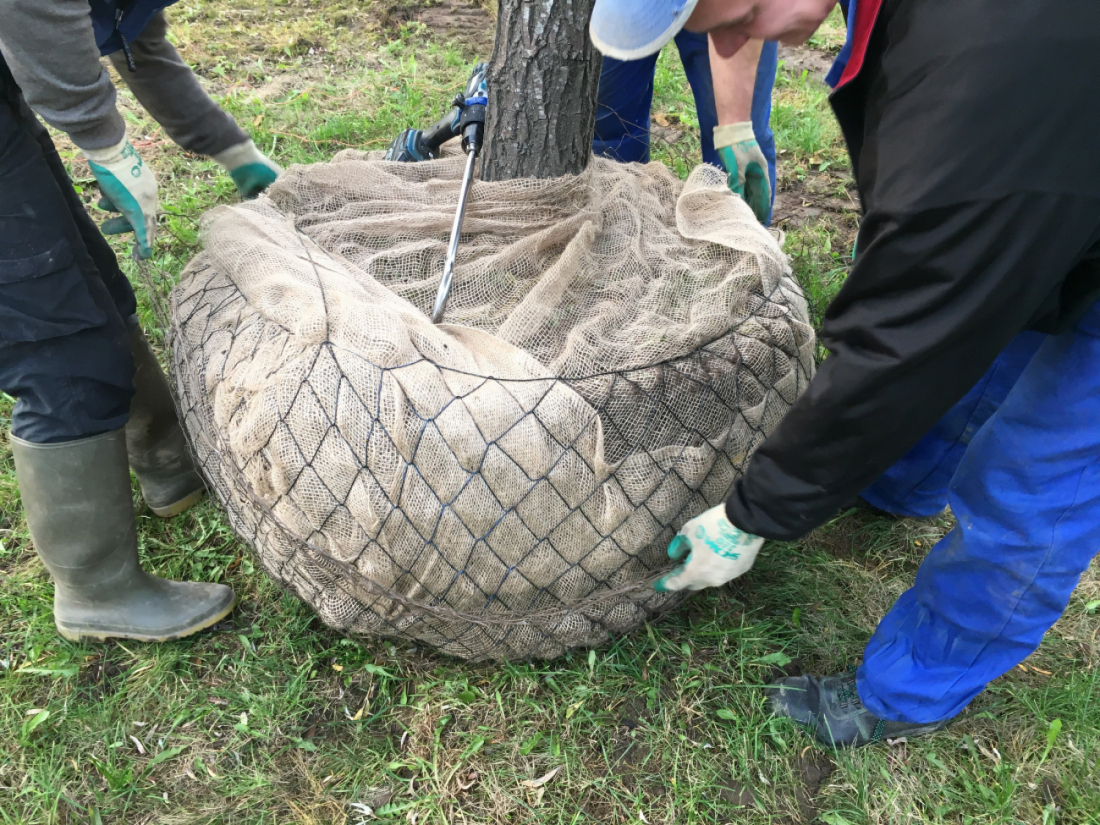Wirebaskets, do they need to be removed before planting the tree?
A discussion that has been carried out often. Removing the wirebasket in planting hole is not without risks. However, the degradation of the wirebasket in the planting hole is a long term process. What should not be forgotten is the material selection. Not all wire baskets, sold in the European nursery sector meet the correct guidelines. In this article we weigh the pros and cons of each choice. In addition we, as Agro “de Arend”, advice you which type of wirebasket meet the correct guidelines. What should you know as a grower before ordering the materials.
Purpose of the wirebasket
Before the tree is planted it has made a long logistic trip. A compact and stable rootball is fundamental to optimal growth after transplanting.
Quote 1 : “The wirebasket needs to be removed from the rootball before planting”
“To judge the rootball and rootsystem correctly, you have to see it with your own eyes”
By quoting this, the reliability and professionality of today’s grower is being questioned. Growers in many parts of Europa guarantee a top-quality and reliable product. By quoting this, the reliability and professionality of today’s grower is being questioned. Growers in many parts of Europa guarantee a top-quality and reliable product.
“For optimal growth after transplanting, it is essential that the roots are in direct contact with the surrounding soil”
We agree! However, the jute hessian degrades in the first month after planting. The roots will develop in the rootball and will grow through the meshes, already in the first weeks. This is optimal. In this case, removing the wirebasket , is a task to many in the plantingprocess and cutting the upper ring of the basket suffices. Possibly the sides of the basket can be folded. This is also how it is described in the RAW conditions & specifications.
Quote 2: “It is not required to remove the wirebasket from the rootball after planting”
“The rootball is never allowed to break apart, when removing the wirebasket”We totally agree! Like said before, , the tree has made a long journey from nursery to final placement. The tree has been loaded and offloaded multiple times and the structure of the rootball has become more loose. This is not a result of a bad developed rootsystem in the nursery. When removing the wirebasket, there is a big risk the rootball will break up and looses his compactness. This has a negative impact on growth after transplanting.
It starts with choosing the right dimension of the wirebasket. When the wirebasket fits well , this means the pull wire at 10cm distance of the stem, there is no direct need to cut the upper ring.
Quote 3 : “The wirebasket is 100% degredable when planted?”
We as a supplier of wirebaskets , can not answer this question with a “yes”. This because the degradability differs per factory and type of wirebaskets. We can not generalize ‘the wirebasket’as product itself.In 2009, the Dutch ‘Raad van de Boomkwekerij’ described the quality standards of the material. Regarding the wirebaskets we found the following description. ‘Wirebaskets can not be galvanized en the wirediameter is not thicker then 2mm. Wirebaskets need to be produced with 100% degradable material’This means that,, based on the devined quality standard , galvanized wirebaskets can be excluded. However , in the European Tree nursery sector, galvanized wirebaskets are still being sold to nurseries. Tree nurseries should be more critical about this.
Practical starting point for a ‘digestible’ wire basket should be that the wire is made of pre-heated iron and not galvanized. Also the extent and duration of degradation depends entirely on the conditions in which the rootball will stand. Type of soil, acidity, humidity etc. determine the final digestibility. The jute digest often in the first 2 months after transplantation. This depends on the weight of the jute used.
The wirebasket itself need 3 to 5 years to degrade. The knots and twists of the wires are the hardest parts to degrade. The wire itself is often oxidated within the first 3 years. In practice, this period is fast enough for the growth of the roots and growth rate in the rootball.







